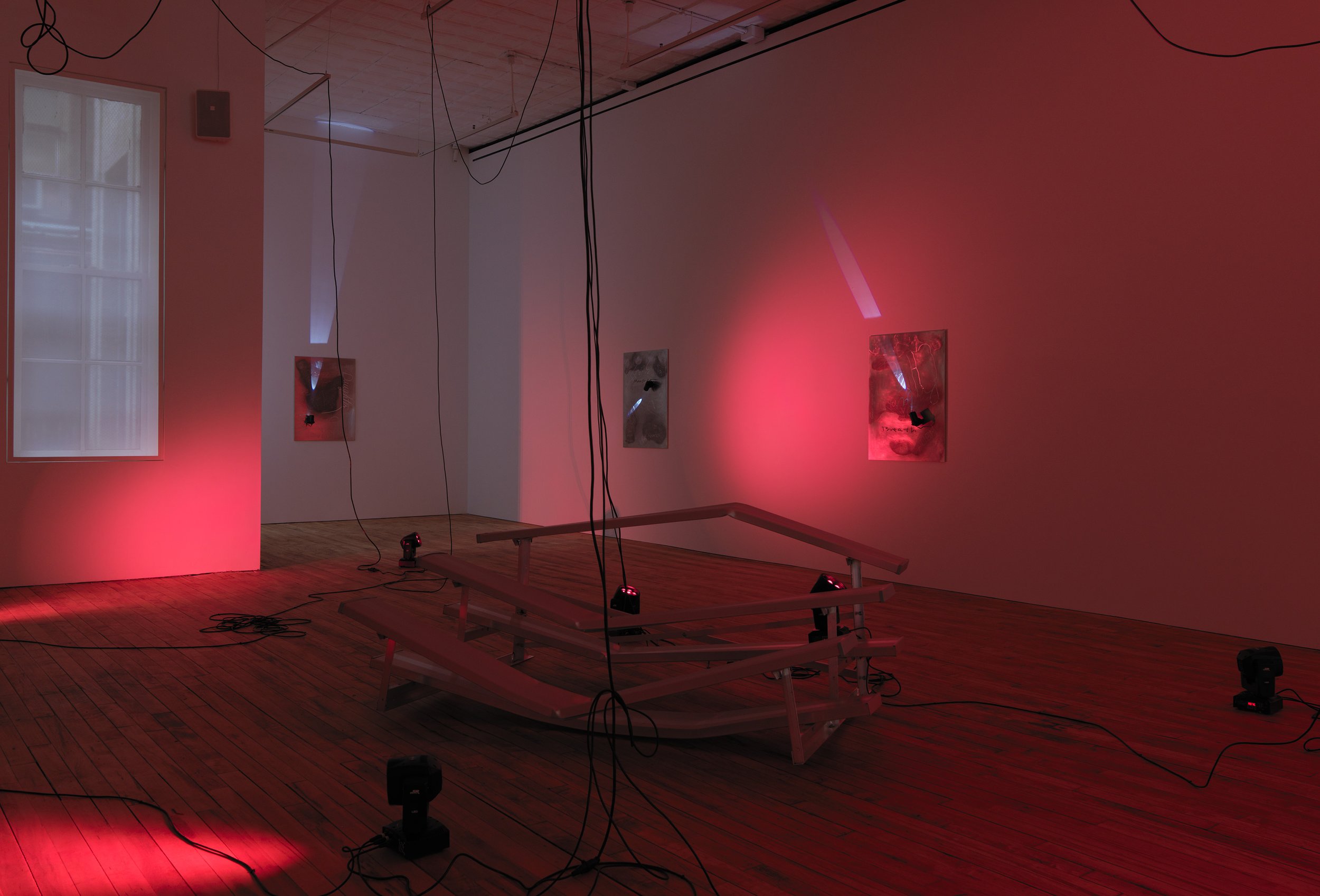Nikita Gale | 'END OF SUBJECT' at 52 Walker
by Madeleine Schulz
Installation view, Nikita Gale: END OF SUBJECT, 52 Walker, New York, January 21–March 26, 2022. Courtesy 52 Walker, New York.
Los Angeles-based artist Nikita Gale presents a new body of work, END OF SUBJECT, at 52 Walker. In END OF SUBJECT, Nikita uses light and sound to explore and disrupt notions of witnessing, visibility, and representation. Through Nikita’s multidisciplinary approach, the artist constructs a sensory experience to interrogate the material limits of ideology. In doing so, Nikita broaches a conversation with the audience and prompts viewers to converse with one another as well.
Below, Nikita shares insights into the artistic process, the questions that inform the work—and that END OF SUBJECT attempts to answer—and the exploration of the relationship between sound, architecture, and the human body.
Nikita Gale, BODY PRINT: BLOOD, 2022. © Nikita Gale. Courtesy the artist and 52 Walker, New York.
What can you tell us about your exhibition, END OF SUBJECT, at 52 Walker? Can you describe your process? From conception to completion?
My exhibition at 52 Walker presents a new group of BODY PRINTS, which are aluminum panels etched both by hand and with the use of machinery, each including an LED spotlight. The BODY PRINTS surround a new installation titled END OF SUBJECT, which is also the title of the exhibition. The installation consists of six sets of bleachers—three have been crushed with applied force, and three were left untouched. The bleachers were then distributed within the space in various orientations. Stage lights are mounted throughout the space, programmed and automated by a show control system designed in collaboration with lighting designer Josephine Wang, and a four-channel audio installation features an original theme by composer Tashi Wada. The audio comprises environmental sounds like rain, thunder, the sound of human laughing and crying, voice-overs from four-voice actors I’ve worked with previously on my performance project AUDIENCING at PS1 in February of 2020, found clips of Toni Morrison reading from Sula, my dog’s barking, and even myself whistling a motif that appears throughout the composition by Tashi Wada. The sounds are from widely disparate contexts so there’s a sense of kind of sonically rummaging through ruins—tidbits and vignettes from widely varying environments and contexts. The site shifts between dormant and active states where the gallery performs as a “gallery” for viewing static artworks and sculptures and then evolves into a more active and visually unstable space where the movement of the lights animates the bleachers and surfaces of the wall works. The piece is organized as a series of two- to eight-minute vignettes that play over a period of about two hours and fifteen minutes.
Where does the title come from? Can you expand on the meaning behind it?
“End of subject” is what you say when you’re leaving an argument. It doesn’t mean you’ve won or lost, but it does mean you’re moving on. A subject is an object of study or attention, but it also refers to how we refer to people in the context of systems of power and control. I’m interested in creating models that demonstrate the possibility of ruining or destroying those systems. It’s in this destruction that I’m able to point to the instability of the structures that tell us what things are worthy of attention and how personhood, subjectivity, and all of the facets of identity get articulated and defined.
Installation view, Nikita Gale: END OF SUBJECT, 52 Walker, New York, January 21–March 26, 2022. Courtesy 52 Walker, New York.
Nikita Gale, BODY PRINT: BREATH, 2022 (detail). © Nikita Gale. Courtesy the artist and 52 Walker, New York.
In order to make these works, you inquired: “What lies between the bodies and the sounds and the stage and the lights—what are we to each other in the act of witnessing? What have we agreed upon through the mere act of showing up?” Did you find an answer?
Yes, but it’s not something I can simply land on. For me, the answer is in the experience of this space that I’m offering up through this installation. The answer is in the conversations that I get to have with an audience through the work but it’s also in the conversations that the audience for the work ends up having with each other. I’d say I am always finding an answer but it’s more of an ambient slow burn than an “aha” moment. The most important thing to know is that doing this work helps me to remember the importance of experiencing how sound and architecture can activate different parts of the structures that we rely on to define ourselves and others.
How does the use of lighting, staging, atmosphere, and sound imitate the presence of a human body? What did the creative process behind the work look like?
The sonic elements of the work are meant to be both alienating and grounding. I’m interested in the ways that objects condition social behaviors. I’m really into pop music, and at concerts, I see how people orient themselves around a stage and follow the spotlight with their gaze. That ties into this larger conversation about power and authority, and how those systems direct our bodies to move in certain ways, to look at particular things, or to receive certain types of information. I think that’s an incredibly useful metaphor for me to think about power in the context of the public arena—the stage, or wherever we focus our attention, represents where power is concentrated, or rather where power wants us to look or direct our attention.
Nikita Gale, BODY PRINT: MUSCLE, 2022 (detail). © Nikita Gale. Courtesy the artist and 52 Walker, New York.
You explain that your work also constitutes the expectations of a human body shaped by existing social and political systems. What systems are you mostly interested in talking about? And what further commentary is it making?
I use infrastructural vernacular elements—like barricades and bleachers—to refer to objects that orient our navigation of space, and I use the term “space” both as a reference to architecture but also as a reference to social and psychological space. In END OF SUBJECT, the bleachers stand in as a kind of shorthand for the intersubjective act of witnessing; those objects represent the tacit agreement between the audience and the materials that enable the act of viewing and experiencing.
Nikita Gale, 2021. Photo by Lelanie Foster
The exhibition is on in New York City until March 26, 2022 at 52 Walker.






